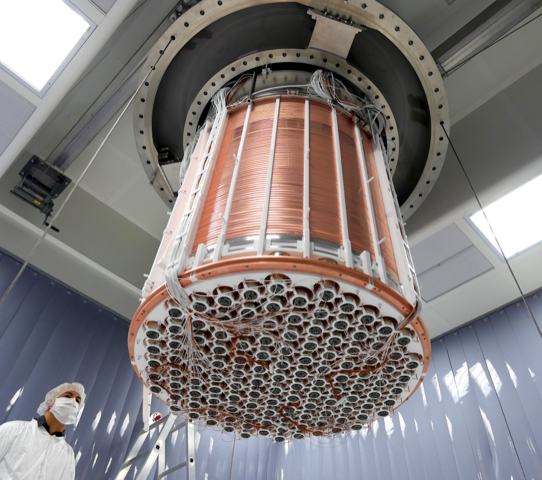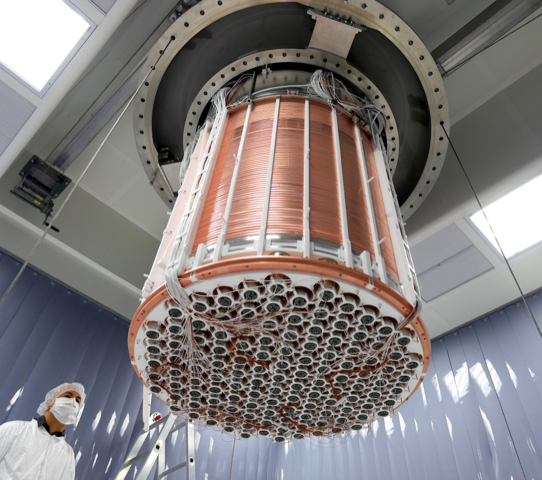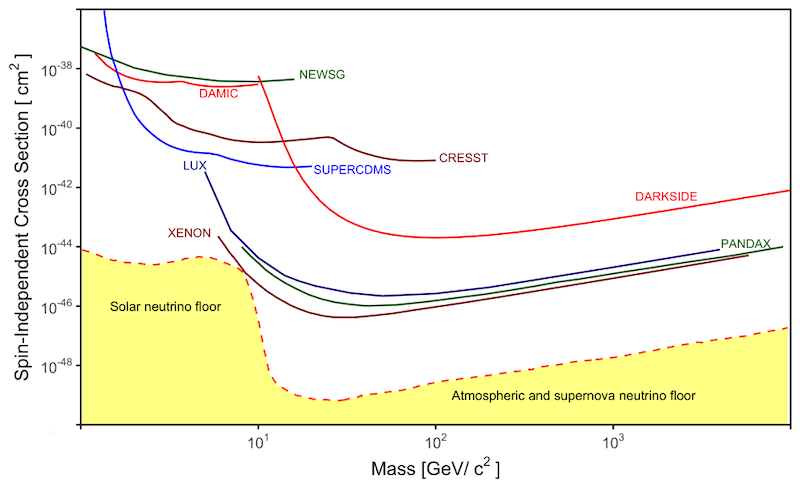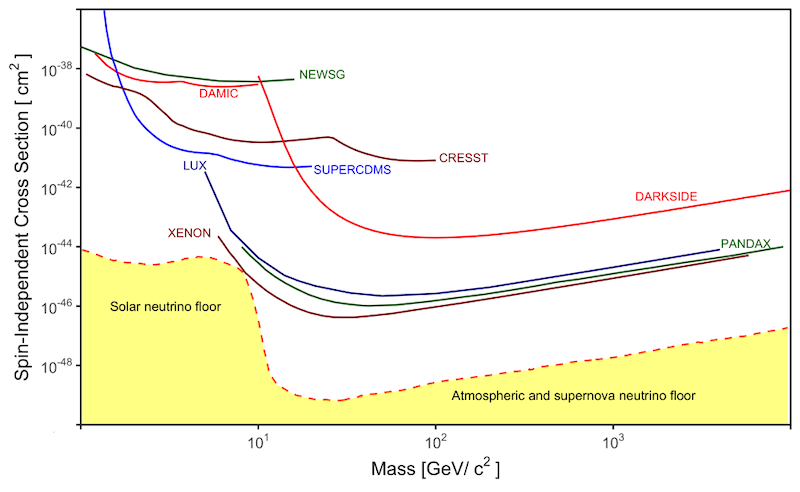Neutrinos Rising from the Floor
The “neutrino floor” has been looming under dark matter searches for years. This neutrino background is still below the sensitivity of dark matter detectors, but as such detectors continue to become more sensitive, it’s only a matter of time before neutrino events will begin to dominate the signal. Reaching this floor might sound like bad news, but some researchers see it as an opportunity for gaining new information about neutrinos, as well as for potentially uncovering particles and interactions beyond the standard model of particle physics.
The neutrino floor is the result of a particular neutrino interaction called coherent elastic neutrino nucleus scattering, or CE𝜈NS (pronounced “sevens”). “If you’re searching for dark matter, CE𝜈NS is a background. If you’re searching for neutrinos, it’s a signal,” says Louis Strigari from Texas A&M University. The first observation of CE𝜈NS happened just four years ago in an accelerator-based experiment. Now, a dozen other experiments are aiming to retrieve a CE𝜈NS signal. At the Weak Interactions and Neutrinos 2021 conference earlier this month, Strigari gave an overview of what CE𝜈NS holds in store for researchers.
First postulated in the 1970s, CE𝜈NS occurs when a neutrino “bumps” into a nucleus and gives it a kick. Compared to other neutrino-nucleus interactions in which the neutrino interacts with a single neutron or proton, CE𝜈NS is a coherent interaction between the neutrino and all the neutrons and protons in the nucleus. This larger target (or “cross section”) makes CE𝜈NS much more likely than other neutrino interactions with individual nucleons or electrons. On the flip side, the kick, or recoil, that the nucleus receives is tiny, making CE𝜈NS very difficult to observe.
Despite this difficulty, proposals for detecting CE𝜈NS go back 40 years. The early designs for CE𝜈NS detectors were based on scintillators in which the nuclear recoil produces an observable light flash. Researchers later adopted this scintillator technology to search for dark matter particles called WIMPs. “It’s actually kind of funny that we’re coming back full circle,” Strigari says, as researchers are looking to use dark matter detection technology for studying CE𝜈NS.
The XENON Collaboration, which operates a large dark matter experiment at the Gran Sasso National Laboratory in Italy, recently performed a dedicated search for CE𝜈NS. The team focused on a specific source of neutrinos—those coming from boron-8 nuclear reactions in the Sun. In the XENON detector, these neutrinos are expected to produce a CE𝜈NS signal that is indistinguishable from a WIMP with a mass of 6GeV/c2. This indistinguishability is what makes CE𝜈NS neutrinos anathema to dark matter scientists. “It’s a background that you can’t discriminate from your signal,” says XENON team member Joseph Howlett, a graduate student at Columbia University, New York. He and his colleagues estimated that CE𝜈NS neutrinos may already be identifiable in XENON observations. To test this possibility, they reanalyzed some archived data—relaxing certain selection criteria and eliminating some other backgrounds—but in the end they didn’t uncover a CE𝜈NS signal. The situation may change with upgraded detectors at XENON and other dark matter facilities. “There’s a good chance that in the next few years, we will begin to see these events,” Howlett says.
The only experiment that has captured a CE𝜈NS signal so far is COHERENT—a dedicated CE𝜈NS project at the Spallation Neutron Source in Tennessee. The experiment takes advantage of a high-energy neutrino beam, generated as a by-product from an accelerator experiment. In 2017, the COHERENT Collaboration reported the first observations of CE𝜈NS events in a cesium iodide scintillator. And earlier this year, the team released evidence of CE𝜈NS in a different type of detector, one based on argon. The reason for changing the type of detector is that the CE𝜈NS interaction should depend on the size of the target nucleus, explains Kate Scholberg from Duke University in North Carolina, who is the spokesperson for COHERENT. In particular, the CE𝜈NS rate is predicted to be proportional to N2, where N is the number of neutrons. “We would like to probe different values of N to test this dependence,” Scholberg says.
COHERENT is planning to measure CE𝜈NS with other types of detectors, such as those based on germanium and sodium iodide. At the same time, several other experiments, such as TEXONO in Taiwan and CONNIE in Brazil, have installed detectors next to nuclear reactors, allowing them to study CE𝜈NS with reactor neutrinos. Some of these projects, Strigari says, have spontaneously sprung up in physics departments that had some extra dark matter detector equipment and a nearby neutrino source. “It’s a really experimentally favorable field, where it doesn’t take huge detectors or huge collaborations,” Strigari says.
One of the reasons to study CE𝜈NS is to look for new physics. “Because the nucleus just looks like a single, structureless particle to a neutrino that kicks it via CE𝜈NS, there are few uncertainties in the process due to internal nuclear structure,” Scholberg says. If neutrinos do exhibit nonstandard interactions with neutrons, for example, then the coherent aspect of the CE𝜈NS interaction could boost that effect. “In some sense, you amplify a new physics signal,” Strigari says.
There are other questions that CE𝜈NS research might tackle, such as whether or not the so-called sterile neutrino exists (see Viewpoint: Sterile Neutrino Down but Not Completely Out). Some neutrino experiments have observed a deficit in neutrino counts, which might be explained by the three standard-flavor neutrinos transforming into undetectable sterile neutrinos. As CE𝜈NS is a flavor-independent interaction, it might offer a new way to test this sterile neutrino hypothesis.
Of course, the more sensitive that detectors become to CE𝜈NS neutrinos, the harder it will be for them to spot other particles. “Mitigating this background is one of the biggest challenges to dark matter experiments in the coming decade,” Howlett says. Some mitigation strategies are being proposed, such as making detectors with direction sensitivity or including spin dependent effects (see Synopsis: Discriminating Dark Matter from Neutrinos). But meeting the CE𝜈NS-detection challenge could offer the chance to learn new and perhaps unexpected things about neutrinos. “That’s an opportunity that dark matter detectors can fulfil,” Howlett says.
–Michael Schirber
Michael Schirber is a Corresponding Editor for Physics Magazine based in Lyon, France.







